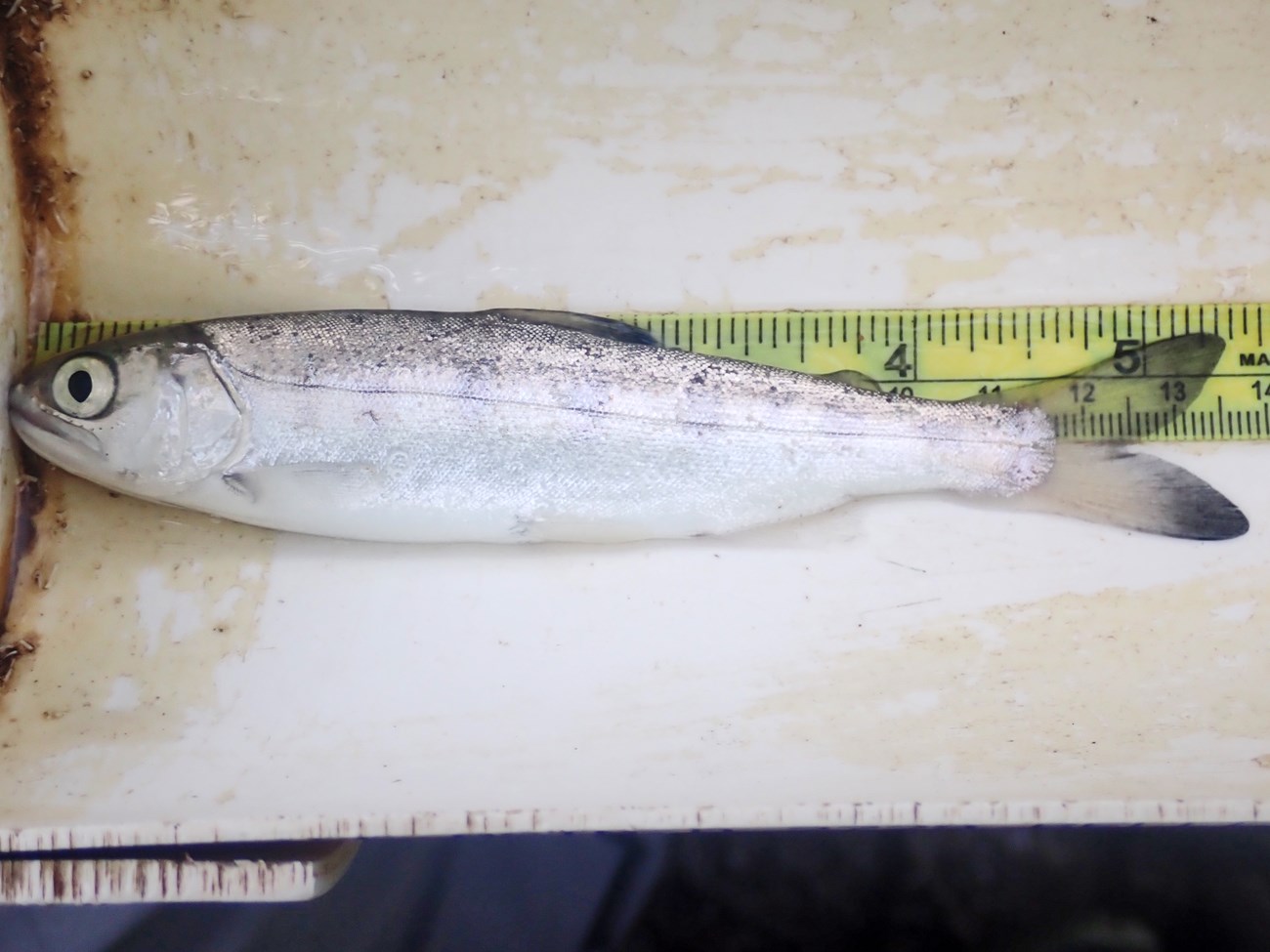Last updated: July 24, 2025
Article
2025 Coho Smolt Migration Comes to a Close
By Scientists in Parks Intern Brooke Harvey and Field Crew Lead Brentley McNeill, San Francisco Bay Area Network Salmonid Monitoring Program

NPS / Environment for the Americas / Avani Fachon
July 2025 - The San Francisco Bay Area Network salmonid monitoring crew is happy to announce that we have completed our 2025 spring smolt monitoring season! Smolts are young salmon or trout leaving the streams where they were born to enter the ocean. Our program has been using traps to monitor migrating smolts for more than 20 years. Our data helps parks track changes in abundance and better understand when smolts are on the move. Overall, we found it was a decent year for endangered coho salmon smolts journeying out of Olema Creek in Point Reyes and Redwood Creek in Muir Woods and Golden Gate.
Big changes for life at sea
Salmon and trout are anadromous fish, meaning they spend portions of their lives in both freshwater and saltwater. To prepare for the transition to life at sea, smolts go through a process called smoltification which involves substantial hormonal changes. When we process (ie. measure and weigh) the smolts captured in our traps, they can be at various smoltification stages. A more developed coho smolt will typically have bright, silvery scales and dark coloration along the edge of its tail (caudal) fin as you can see in the photo below. The vertical bars (parr marks) along the body of this smolt have also faded.

NPS / Michael Reichmuth
Fish funnels and water slides
This spring, we installed the Olema Creek smolt trap on March 24th and the Redwood Creek trap on March 25th. Our smolt trap design involves multiple features and pieces of equipment. First and farthest upstream is a fyke net that acts as a funnel for smolts swimming downstream. The fyke net is reinforced with erosion cloth and sandbags to prevent the streambed from scouring under it. Next to the fyke net along either the left or right steam bank, we leave a small section of stream unimpeded. This “bypass channel” allows adult steelhead to enter and exit the stream freely after spawning. Another component of the smolt trap is the large-diameter pipe that carries fish from the fyke net area downstream to the live box. Think of the pipe as a moderately-sloped water slide that promotes fish movement.
The final piece, the live box, is wooden and equipped with mesh sidewalls so water can pass through and the smallest, most sensitive fish—like coho and steelhead fry—can escape. The live box is stabilized at each corner by a T-post and bailing wire which also allows us to move the box up and down in response to streamflow. We want flow through the pipe to be just right; not so high as to create strong turbulence in the box, and not so low that bigger smolts can jump back into the pipe and swim upstream thereby avoiding capture. We achieve optimal flows throughout the season by adjusting the height of the box and placing or removing sandbags near the fyke net.

Point Reyes National Seashore Association / Avani Fachon
Sort, scan, measure
During the smolt-trapping season, we operate traps seven days a week, unless prevented by rain and/or high wind storms. Our first task upon arriving at the trap site is assessing for anomalies in the live box and fyke net. It is important to keep these areas clear of debris and clogging to avoid injuries to fish. After this initial assessment comes our favorite part: scooping fish! We use a large dip net to clear fish from the live box and sort smolts from other species like three-spined stickleback and sculpin into buckets. After sorting, we bring the buckets to the stream bank where we have a processing station. There, we measure and weigh a percentage of the smolts and non-salmonids and tally any remaining fish.

NPS / Michael Reichmuth
We also scan all coho smolts with a handheld passive integrated transponder (PIT) tag reader. We placed PIT tags in some coho when they were juveniles to be able to track their life history. We measure and weigh every smolt with a tag so we can determine growth from when the fish was initially tagged.
Preliminary results
After a fairly busy trapping season that concluded at the end of May, we have preliminary raw smolt counts for both Olema and Redwood Creeks. We captured more than 2,000 coho smolts in the Olema Creek trap, which is the highest raw smolt count we’ve had for this cohort since monitoring began. At the Redwood Creek trap, we captured almost 1,000 smolts—far more than we captured in 2022, the last time we saw smolts from this cohort of fish. Using PIT tag data, we confirmed that most of the Redwood Creek smolts were juveniles from Warm Springs Hatchery released last November. That’s a sign that these released fish had sufficient habitat to survive the winter and are boosting the tiny remaining wild population as intended. We’re still in the process of data validation and will have total coho smolt abundance estimates in the near future, so stay tuned! These estimates will account for the fact that our traps don't catch every migrating smolt.
In fact, detection data from our newly-installed PIT-tag antennas in Olema and Redwood Creeks showed that some coho made their way downstream of our trap sites before the smolt monitoring season even began. We hope to investigate this further and determine exactly what percentage of each population starts migrating to the ocean early.
We also captured more than 200 steelhead smolts and 1+ (juveniles at least one year old but not yet fully exhibiting smolt characteristics) in the Redwood Creek trap. No steelhead 1+ and only a handful of steelhead smolts were captured on Olema Creek. We did, however, record a decent number of coho fry—and even a few Chinook fry—at the Olema trap, indicating successful spawning this past fall and winter.
So, it’s so long to the smolts as they make their way to the Pacific and we transition to monitoring juvenile coho this summer. We look forward to seeing the smolts again as spawning adults in winter 2026-27!
For more information
- San Francisco Bay Area Network Salmonid Monitoring webpage
- Pacific Coast Science & Learning Center Coho & Steelhead webpage
- Contact Fishery Biologist Michael Reichmuth

See more from the Bay Area Nature & Science Blog
